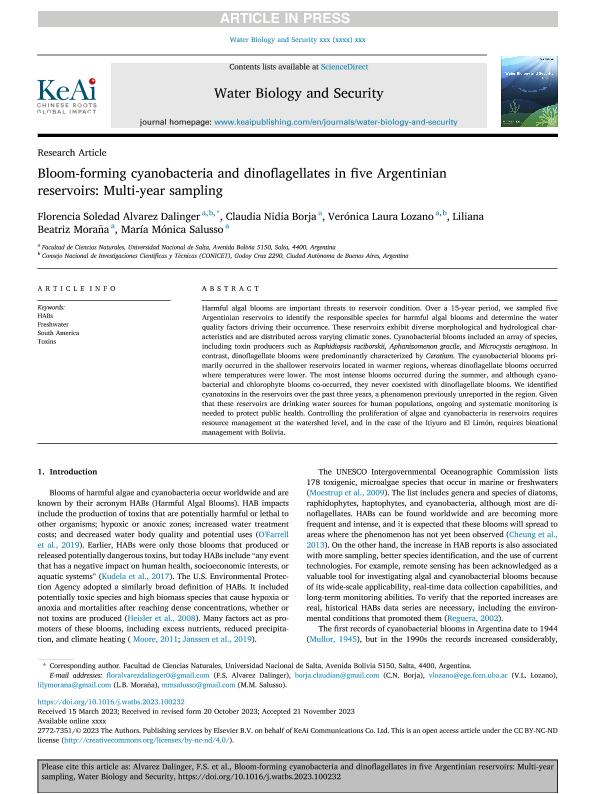Artículo
Bloom-forming cyanobacteria and dinoflagellates in five Argentinian reservoirs: Multi-year sampling
Alvarez Dalinger, Florencia Soledad ; Borja, Claudia Nidia; Lozano, Verónica Laura
; Borja, Claudia Nidia; Lozano, Verónica Laura ; Moraña, Liliana Beatriz; Salusso, Maria Monica
; Moraña, Liliana Beatriz; Salusso, Maria Monica
 ; Borja, Claudia Nidia; Lozano, Verónica Laura
; Borja, Claudia Nidia; Lozano, Verónica Laura ; Moraña, Liliana Beatriz; Salusso, Maria Monica
; Moraña, Liliana Beatriz; Salusso, Maria Monica
Fecha de publicación:
11/2023
Editorial:
Elsevier
Revista:
Water Biology and Security
ISSN:
2772-7351
Idioma:
Inglés
Tipo de recurso:
Artículo publicado
Clasificación temática:
Resumen
Harmful algal blooms are important threats to reservoir condition. Over a 15-year period, we sampled fiveArgentinian reservoirs to identify the responsible species for harmful algal blooms and determine the waterquality factors driving their occurrence. These reservoirs exhibit diverse morphological and hydrological characteristics and are distributed across varying climatic zones. Cyanobacterial blooms included an array of species,including toxin producers such as Raphidiopsis raciborskii, Aphanizomenon gracile, and Microcystis aeruginosa. Incontrast, dinoflagellate blooms were predominantly characterized by Ceratium. The cyanobacterial blooms primarily occurred in the shallower reservoirs located in warmer regions, whereas dinoflagellate blooms occurredwhere temperatures were lower. The most intense blooms occurred during the summer, and although cyanobacterial and chlorophyte blooms co-occurred, they never coexisted with dinoflagellate blooms. We identifiedcyanotoxins in the reservoirs over the past three years, a phenomenon previously unreported in the region. Giventhat these reservoirs are drinking water sources for human populations, ongoing and systematic monitoring isneeded to protect public health. Controlling the proliferation of algae and cyanobacteria in reservoirs requiresresource management at the watershed level, and in the case of the Itiyuro and El Limon, requires binational management with Bolivia.
Palabras clave:
HABS
,
FRESHWATER
,
SOUTH AMERICA
,
TOXINS
Archivos asociados
Licencia
Identificadores
Colecciones
Articulos(CCT - SALTA-JUJUY)
Articulos de CTRO.CIENTIFICO TECNOL.CONICET - SALTA-JUJUY
Articulos de CTRO.CIENTIFICO TECNOL.CONICET - SALTA-JUJUY
Citación
Alvarez Dalinger, Florencia Soledad; Borja, Claudia Nidia; Lozano, Verónica Laura; Moraña, Liliana Beatriz; Salusso, Maria Monica; Bloom-forming cyanobacteria and dinoflagellates in five Argentinian reservoirs: Multi-year sampling; Elsevier; Water Biology and Security; 11-2023; 1-9
Compartir
Altmétricas



